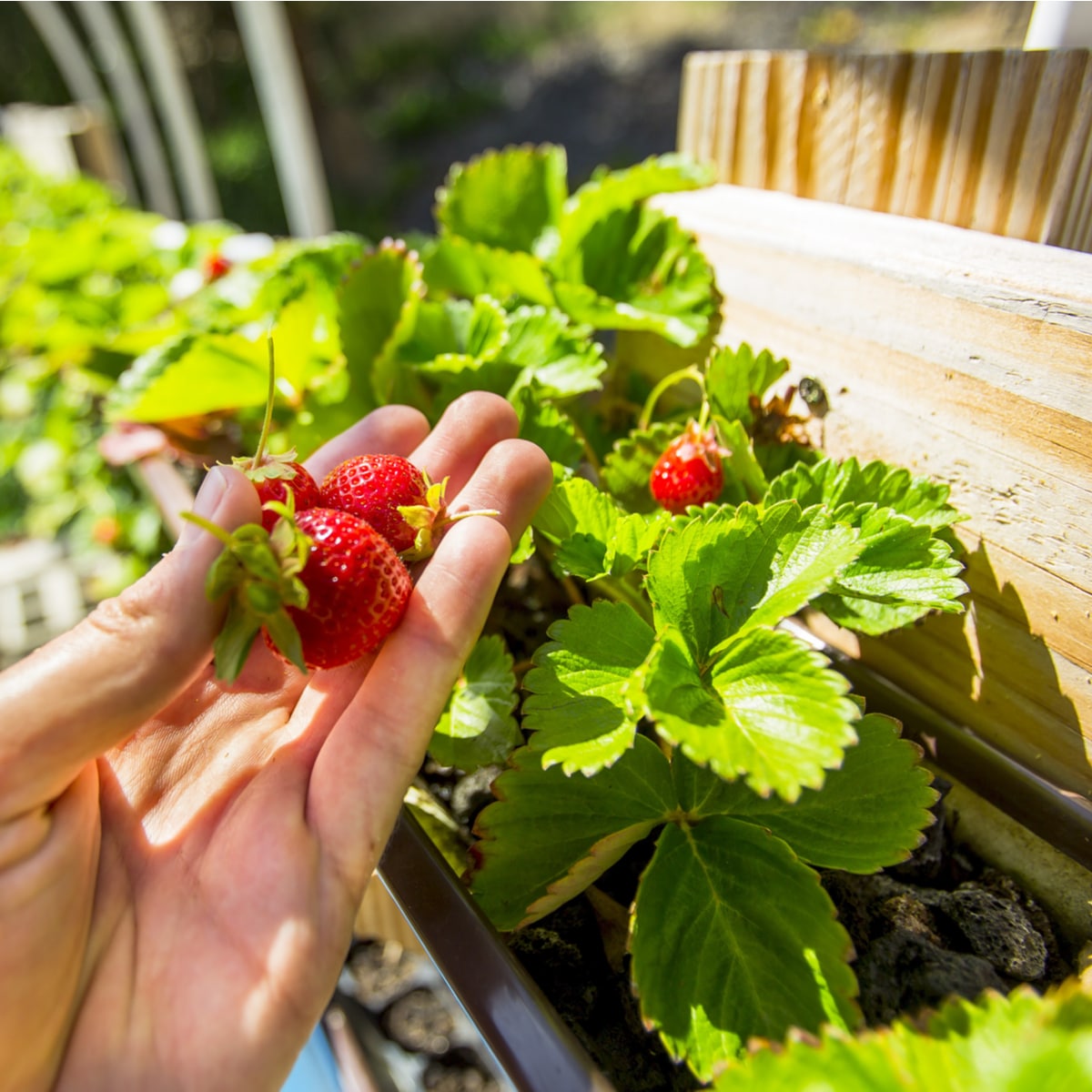To plant strawberries in a gutter, clean the gutter, add soil and compost, place the plants, and water regularly. Growing strawberries can be a rewarding experience, especially when you can enjoy the fruits of your labor.
One unique way to grow strawberries is in a gutter. This method is ideal for those with limited space or who want to utilize unconventional gardening techniques. By following a few simple steps, you can easily plant strawberries in a gutter and enjoy a bountiful harvest.
We will guide you through the process of preparing and planting strawberries in a gutter. So, let’s get started and transform your gutter into a fruitful strawberry patch.

Credit: strawberryplants.org
How to Plant Strawberries in a Gutter: Step by Step Guide
Choosing The Right Gutter For Planting Strawberries
Choosing the right gutter for planting strawberries is crucial in ensuring their successful growth. There are several benefits to growing strawberries in a gutter. Firstly, it allows for better drainage and prevents waterlogging, which can be detrimental to the plants.
Secondly, it saves space, especially for those with limited garden area. Additionally, it provides easy access to the strawberries, making it convenient for harvesting. When selecting a gutter for strawberries, there are a few factors to consider. Firstly, ensure that it is wide enough to accommodate the plants and provide ample space for their root systems.
Secondly, opt for a gutter made from a durable material that can withstand the weight and pressure of the growing plants. Lastly, make sure the gutter has proper drainage holes to prevent water accumulation. By choosing the right gutter, you can create an ideal environment for your strawberry plants to thrive.
Preparing The Gutter For Planting Strawberries
Preparing the gutter for planting strawberries involves cleaning and sanitizing the gutter thoroughly. Start by removing any debris and dirt from the gutter to create a clean environment for the strawberries to grow. Next, sanitize the gutter using a mild detergent or a mixture of vinegar and water to eliminate any bacteria or fungi that could harm the plants.
Once the gutter is clean and sanitized, it’s time to install it in the right location. Choose a spot that receives ample sunlight and has good drainage. Finally, add support brackets to the gutter to ensure stability and prevent it from sagging under the weight of the plants.
With these steps completed, your gutter is now ready for planting strawberries and growing them successfully.
Creating The Ideal Soil Mix For Strawberry Plants
To create the ideal soil mix for strawberry plants, it is crucial to carefully choose the right soil components. Mixing the soil requires a balance between optimal drainage and nutrient retention. This ensures that the strawberry plants have access to the necessary nutrients while also allowing excess water to drain away effectively.
Selecting components like well-rotted compost, perlite, and peat moss can improve the soil’s texture and aeration. These components promote root development and prevent waterlogging, which can be detrimental to strawberry plants. By creating the ideal soil mix, gardeners can provide the necessary environment for healthy and thriving strawberries in a gutter.
Planting Strawberry Plants In The Gutter
Planting strawberries in a gutter is a practical and space-saving solution for gardeners. Before getting started, it is crucial to select healthy strawberry plants that are free from diseases. Once you have the plants, ensure that you space them out adequately in the gutter to allow room for growth and airflow.
This will help prevent overcrowding and disease transmission. When planting the strawberries, make sure to use a well-draining soil mix that is rich in organic matter. This will provide the necessary nutrients for the plants’ growth and fruit production. Gently press the soil around the roots to secure the plants in place.
Regular watering and maintenance are essential to keep the strawberries healthy and thriving. With proper care, you can enjoy a bountiful harvest of delicious strawberries from your gutter garden.
Providing Adequate Water And Nutrients To The Strawberries
Planting strawberries in a gutter requires providing adequate water and nutrients. Establish a watering schedule to keep the plants hydrated. Apply a balanced fertilizer for optimal growth, ensuring the strawberries receive the nutrients they need. Additionally, supplement with organic nutrients to enhance the flavor of the berries.
This combination of water and nutrients will promote healthy strawberry plants and maximize their yield. By following these guidelines, gardeners can enjoy a bountiful harvest of delicious and flavorful strawberries from their gutter garden. So, get started on your strawberry adventure and enjoy the fruits of your labor!
Ensuring Proper Drainage In The Gutter System
Planting strawberries in a gutter requires ensuring proper drainage within the system. Waterlogging in the gutter needs to be prevented to avoid any damage to the plants. To achieve this, it is important to install drainage holes or outlets in the gutter.
These openings will allow excess water to flow out and prevent it from accumulating. Regular monitoring of the drainage system is necessary to ensure that it is functioning effectively. If needed, adjustments can be made to improve the drainage. By taking these measures, the strawberries planted in the gutter will have a healthier and more productive growth.
Protecting Strawberries From Pests And Diseases
Planting strawberries in a gutter can be an effective way to protect them from pests and diseases. By implementing organic pest control methods, you can ensure the health of your strawberries. Identifying common pests such as aphids or slugs is crucial in order to take appropriate measures.
Regularly inspect your plants for any signs of disease, such as wilting or discoloration. By recognizing these signs early on, you can take preventive measures to save your strawberries. Remember to regularly water and fertilize your plants to keep them strong and resilient.
With proper care and attention, you can enjoy a bountiful harvest of delicious, pest-free strawberries. So, start planting your strawberries in a gutter and enjoy the benefits!
Maintaining And Harvesting Strawberries In The Gutter
Planting strawberries in a gutter is a practical and space-saving option for any gardener. Maintaining and harvesting strawberries in this unconventional setup requires attention to certain factors. Regularly checking and adjusting watering and fertilization ensure the plants receive adequate nutrients.
Pruning and removing runners help redirect the plant’s energy towards fruit production, resulting in better yields. Harvesting strawberries at the optimal time is crucial to enjoy their full flavor. By following these guidelines, you can enjoy a bountiful harvest of strawberries grown in gutters, while maximizing space in your garden.
Troubleshooting Common Issues In Gutter Strawberry Planting
Planting strawberries in a gutter can sometimes lead to yellowing leaves and nutrient deficiencies. These issues can be caused by overwatering or underwatering the plants. It’s important to strike the right balance. Extreme weather conditions can also pose a challenge when growing strawberries in gutters.
Too much heat or cold can stress the plants, affecting their growth and fruit production. To troubleshoot these problems, you need to monitor the moisture levels in the gutter and adjust watering accordingly. Regularly check the leaves for signs of nutrient deficiencies and provide the necessary fertilizers.
Shield the plants from harsh weather conditions by using shade cloth during hot spells and covering them during cold periods. By addressing these common issues, you can ensure healthy and productive strawberry plants in your gutter garden.
Creative And Decorative Ideas For Gutter Strawberry Planting
Planting strawberries in a gutter can be both creative and decorative. To make it visually appealing, you can incorporate hanging baskets or trellises for vertical gardening. This not only maximizes space but also adds a unique charm to your garden.
Additionally, integrating companion plants is a great idea for pest control and aesthetics. Choose plants that not only repel pests but also complement the strawberries’ beauty. For example, marigolds can deter pests while adding a vibrant pop of color. Nasturtiums are another great option, with their edible flowers and ability to repel aphids.
By combining different plants and utilizing vertical space, you can transform your gutter strawberry planting into a stunning focal point in your garden.
Frequently Asked Questions Of How To Plant Strawberries In A Gutter
Can Strawberries Be Grown In A Gutter?
Yes, strawberries can be successfully grown in a gutter. By utilizing vertical gardening techniques, gutters provide an efficient way to save space and grow strawberries. The gutter acts as a planter box, allowing for the proper drainage and root growth necessary for healthy strawberry plants.
What Are The Advantages Of Planting Strawberries In A Gutter?
Planting strawberries in a gutter offers several advantages. Firstly, it saves space as the plants can be grown vertically. Secondly, it provides better control over watering and nutrient levels, resulting in healthier plants. Lastly, it minimizes the risk of pests and diseases by elevating the plants away from the ground.
How Should I Prepare A Gutter For Planting Strawberries?
To prepare a gutter for planting strawberries, start by drilling small drainage holes along the bottom. Next, line the gutter with a geotextile fabric to prevent soil erosion. Fill the gutter with a mixture of peat moss, compost, and perlite for optimal drainage and nutrients.
Finally, plant strawberry seedlings or runners evenly along the gutter.
What Is The Best Time To Plant Strawberries In A Gutter?
The best time to plant strawberries in a gutter is during the early spring or fall. This allows the plants to establish their roots before the hot summer or freezing winter months. It is important to avoid extreme temperatures as it can stress the plants and hinder their growth.
How Often Should Strawberries In A Gutter Be Watered?
Strawberries in a gutter should be watered consistently to keep the soil moist but not waterlogged. Generally, a thorough watering once or twice a week is sufficient. However, this may vary depending on weather conditions. It’s crucial to monitor the soil moisture and adjust the watering frequency accordingly.
Are There Any Specific Care Tips For Growing Strawberries In A Gutter?
Yes, there are a few care tips to ensure successful strawberry growth in a gutter. Regularly check the gutter for proper drainage and remove any accumulated debris. Apply a balanced organic fertilizer every four to six weeks during the growing season.
Additionally, protect the plants from extreme weather conditions and harvest ripe strawberries promptly to promote continuous fruiting.
Conclusion
Strawberries can thrive in unusual spaces like gutters, bringing a touch of sweetness to any urban garden. By following a few simple steps, you can successfully plant strawberries in a gutter and enjoy a bountiful harvest. Remember to prepare the gutter properly by adding drainage holes and a layer of gravel for optimal water flow.
Use a high-quality potting mix to provide the strawberries with the nutrients they need to grow. Regular watering and occasional fertilizing will keep your strawberry plants healthy and productive. Additionally, it’s important to protect your strawberries from pests and diseases by monitoring them regularly and taking appropriate measures.
With a little patience and care, you’ll be rewarded with juicy, homegrown strawberries that will make a delightful addition to your meals and desserts. So, why not give gutter gardening a try and enjoy the taste of freshly picked strawberries all season long?

